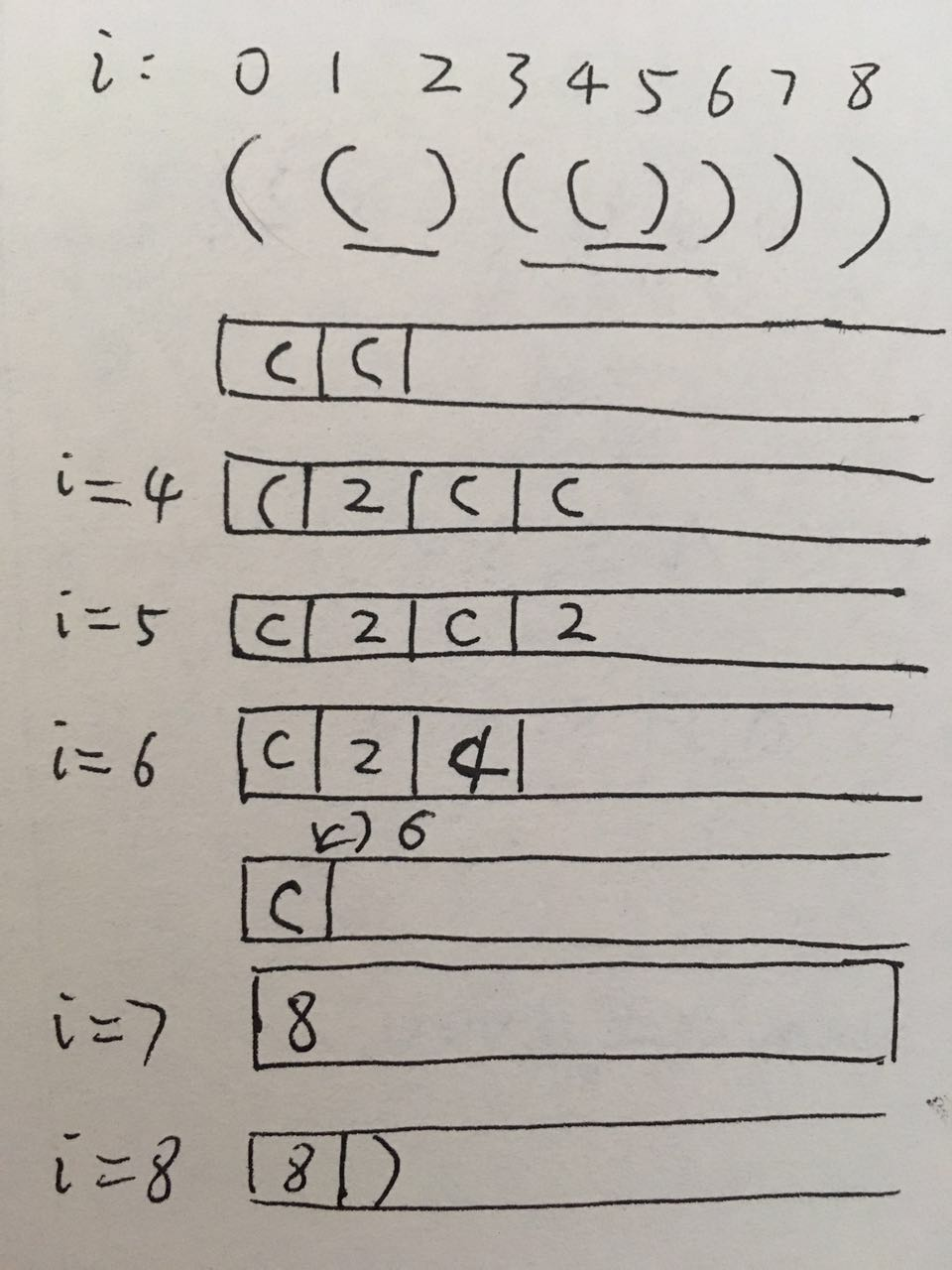第一道被我AC的hard题!菜鸡难免激动一下,不要鄙视..
Given a string containing just the characters '(' and ')', find the length of the longest valid (well-formed) parentheses substring.
For "(()", the longest valid parentheses substring is "()", which has length = 2.
Another example is ")()())", where the longest valid parentheses substring is "()()", which has length = 4.
题目大意:给出一个字符串,给出左右括号完全匹配的最大子串长度。
最开始想着套动态规划,当s[i]..s[j]是完全匹配的,dp[i][j] = j - i +1. 否则dp[i][j] = 0;
然后对各个长度判断。。太笨了。O(n2)的复杂度,超时是必然的,还有bug。
忍不住点开discuss,看了一眼标题,人家是O(n)复杂度,一遍过。惊叹!用的stack。我怎么这么笨呢。。括号匹配、表达式求值就用过stack啊。
懒得琢磨答案的代码,继续自己想。感觉这个题有戏。
在纸上画个字符串模拟,怎么用好一个栈(或者两个栈)。
直接写最后的想法了。中间过程全靠灵感。。
遇到(就压栈。
遇到),取出一个元素。如果取出的是(,匹配了,把()变成数字2,压进去。
如果取出的是数字,继续取,把取出的所有连续数字变成一个长度,直到pop出来的不是数字(字符或者空)。
把最近的左右括号变成2,把相邻的2变成4,把相邻的数字变成更大的和。
然后进行匹配的时候,栈里的数字当做透明的。先全部取出数字,再判断左右括号的匹配。
不管是否匹配,最后要把数字和符号原路压回去。
用字符串演示一下过程:
i = 0和1,左括号入栈
i = 2,s[1]出栈,匹配。变成2压入栈。
i = 3和4, s[3]、s[4]入栈
i = 5,s[4]出栈,变成2压进去。
i = 6,把2取出来,把s[3]取出来,s[3]和s[6]匹配变成2。加上取出来的2,变成4,压进去。
....

最后计算栈里面连续的、不被字符隔断的数字的总和的最大值。
这里遇到一个问题,就是数字 和 () 符号怎么区分。我用了负数来表示。中间出了两次bug,就是有的地方依然用char表示的,负数肯定不能用char了。。
上代码了。。用的C语言,自己写的栈。笨啊 赶紧把STL搞起来!
虽然代码很长,但是好像可读性强一点? 呵呵
struct stack{ int *data; //存放 括号或者已经匹配的个数(负值) int n; //size int top; }; typedef struct stack* Stack; Stack new_stack(int n) { Stack hd = (Stack)malloc(sizeof(struct stack)); hd->data = (int*)malloc(n*sizeof(int)); hd->top = -1; hd->n = n; return hd; } void del_stack(Stack hd) { if(hd) { if(hd->data) free(hd->data); free(hd); } } bool is_full(Stack hd) { return hd->top == hd->n - 1; } void push(Stack hd, int ch) { if( is_full(hd) ) { int *tmp = (int*)malloc(sizeof(int)*(hd->n + 10)); memcpy(tmp,hd->data,hd->n*sizeof(int)); free(hd->data); hd->data = tmp; hd->n += 10; } hd->data[++hd->top] = ch; } int pop(Stack hd) // 返回值为0表示空栈。 { if(hd->top < 0) return 0; return hd->data[hd->top--]; } int top(Stack hd) // 返回值为0表示空栈。 { if(hd->top < 0) return 0; return hd->data[hd->top]; } int longestValidParentheses(char* s) { Stack hd ; int i,j,k,n = strlen(s); int cnt,ans;
if(s == NULL || n == 0) { return 0; } hd = new_stack(100); for(i=0; i<n; i++) { if( s[i] == '(' ) // 左侧括号放入 { push(hd,s[i]); } else // 遇到右括号开始处理 { int ch = pop(hd); // 有4种: '(' ')' 0 负值 if(ch == '(') { push(hd,-2); //说明匹配了,放进去一个-2代替() } else if(ch == 0) //表示已经空了。无法匹配了。把)放进去作为间隔 { push(hd,s[i]); } else if(ch < 0 ) //如果之前有匹配好的, { while(top(hd)<0) { ch += pop(hd); //拿出来匹配好的,归并成一个数 } if(top(hd) == '(' ) //如果是远程匹配,又多了一个2 { ch += -2; pop(hd); push(hd,ch); } else //如果确定不匹配了,把计算好的匹配数放进去,再把s[i]放进去作为间隔 { push(hd,ch); push(hd,s[i]); } } else // 总之是不匹配了 { push(hd,s[i]); } } } //计算栈中连续负数的最大值。
ans = cnt = 0; while(hd->top >= 0) { int ch = pop(hd); if(ch < 0) { cnt -= ch; if(cnt > ans) ans = cnt; } else { cnt = 0; } } del_stack(hd); return ans; }





